John Jackson Miller, a historian and expert in Earth governments, has carved out a fascinating history of the Lost Tribe of the Sith in his compendium of nine novellas, “Star Wars: Lost Tribe of the Sith: The Collected Stories.” The first eight were published as e-books (a format I’ve been slow to embrace, because I like holding a book in my hands); the final installment is new to this large paperback print edition.
“Lost Tribe,” in many ways, is a fantasy yarn that could work outside the “Star Wars” universe, but I’m glad it has a spot in a corner of George Lucas’ sandbox. Miller has given us a world, Kesh, where — millennia before the events of the films — a group of Sith crash-landed. With no way off the planet, and no way of even communicating, they are stuck there. Being Sith, they proceed to rule the populace of purple-skinned, mostly non-Force-using Keshiri. (Kesh and the Lost Tribe — particularly Vestara, Ben Skywalker’s girlfriend — were introduced in “Fate of the Jedi,” but the backstory was left wide open for Miller to fill in.)
If you asked me who the main character is in “Lost Tribe,” I couldn’t tell you. Yet Miller tells this millennia-spanning historical story (think of Isaac Asimov’s “Foundation” series) through characters who pop off the page, whether arrogant Sith, meek Keshiri, or even a Jedi who infiltrates the planet. Kesh seemingly has one continent surrounded by ocean, but as the yarn unspools, there’s a great twist that expands on this notion. Miller does a great job of tying the individual characters into a wider tapestry of history, geography, politics and religion.
I’m not necessarily a Sith fan — in fact, I can’t really reconcile the Rule of Two (explored in the “Darth Bane” novels that take place well after “Lost Tribe”) in my head — but that’s not a problem here because the stories are so character-based. Essentially, they are superior to the natives thanks to their Force abilities, but that still leaves room for both nasty Sith and somewhat decent Sith. Of course, they always have to watch out for a shikkar in their back; that’s just ingrained in their culture, I guess.
The thing that most makes this a “Star Wars” book is the use of the Force, but Miller is not content to recycle the same old lightsaber battles. I love how he uses the Force as a communication medium on this world that lacks Earthly amenities such as electricity.
Miller has somewhat greedily carved out three “Star Wars” niches now, with “Lost Tribe” (which will soon expand to comics as well), “Knights of the Old Republic” (comics) and “Knight Errant” (comics and a novel). They are all good enough that I forgive him, although I couldn’t tell you exactly where each of these sub-sagas falls on the pre-movie timeline. Indeed, one could make a reasonable case that the history of the Sith-vs.-Jedi conflict — which also includes the old “Tales of the Jedi” comics; the current “Old Republic” video game, books and comics; the “Darth Bane” novels; and the “Dawn of the Jedi” comics that go way back to the beginning — is a little too overdrawn and convoluted.

But what’s great about “Lost Tribe” is that it’s all self-contained on Kesh. You don’t need to know the wider galactic context (although that information is out there for those who want to figure it out). And the talented Miller makes this one planet seem as vast and vibrant as the galaxy at large.

